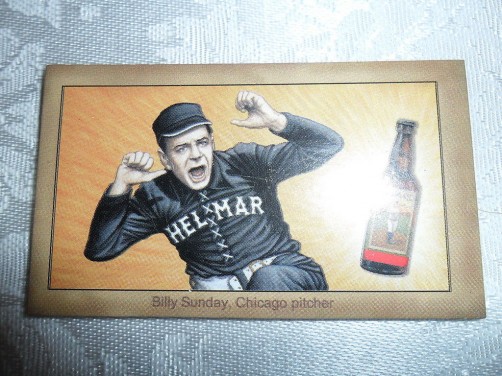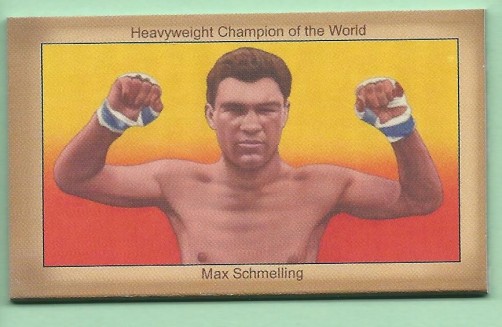Helmar Brewing:
Collector score: * (1 Stars)
Helmar Brewing is a “contract brewer” of beer. That simply means that they do not brew beer (in spite of their name), rather, they buy beer from real breweries and slap their label on it. However, they do not seem to actually be in the beer business, as their web site does not offer any way of ordering beer or finding distributors.
What they are in the business of doing is printing “baseball cards” on an inkjet printer and selling them in the $20 to $250 range on eBay.
Simply put, the cards are awful. In fact, the word awful isn’t strong enough. Here’s why:
First and foremost, a person buys a sports card, especially a tribute card, as a little piece of history. The writing and images found on the card ought to be accurate. Look carefully at this Helmar card of Billy Sunday which sold recently for $25 on eBay:
You probably noticed right away that it says Billy is a pitcher. That’s a pretty glaring error. Billy was an outfielder, and most baseball fans know that. You don’t have to be a SABR nerd to know that Billy wasn’t a pitcher, even kids know that.
But even if you know nothing at all about baseball, Sunday looms large in American history.
More than any other person, he legitimized the prohibition movement. Sure, Carrie Nation raised hell with her hatchet act, but she and her ilk were a sideshow. It was Billy Sunday who galvanized an entire nation to outlaw alcohol consumption. It was Billy Sunday who convinced more than half of all Americans that alcohol was the Devil’s tool to ruin lives. Billy Sunday walked away from the sport he loved and dedicated the next three decades of his life to stamping out the use of alcohol. He traversed the land, giving stirring sermons which were heard by millions.
So how do you think he’d feel about having his picture on a card advertising a brewery? With a giant beer bottle, and wearing a shirt advertising beer? He’s probably revolving in his grave!
Then there’s this gem of German boxer Max Schmeling:
You probably noticed immediately that his name is misspelled, even if you’re not a big fan of boxing.
I didn’t look for bad examples – these were the first two Helmar cards I looked at on eBay!
Since the cards are created using an inkjet printer, and sold on eBay, you would think that the creator of the cards would have access to a computer, and know about Google, and would at least look up the player to make sure the name and any other details are correct. This makes one think that Helmar cards are not created by a sports fan, certainly not a baseball fan, and their home-made “cards” are just a way they have found to make money selling a product of dubious value.
These are cards apparently created by and for the “illiterati”. If you do not read your baseball cards, and only look at the pictures, these cards might be for you.
The name of this outfit is troubling as well. There was a Helmar Tobacco company which issued old tobacco cards about 100 years ago. They made beautiful lithographic cards which were inserted into their products. These cards are very valuable today. This questionable use of the Helmar name is a gimmick, and is confusing to novice collectors. This company has no relation to the original Helmar cards, and is simply trading on their good name.
Another gimmick is that these cards are intentionally damaged in order to make them appear old. Since any book value would have to be based on card condition, how would one account for the intentional damage done to them?
Because these cards are not printed on a printing press, they cannot have any book value. Cards created using digital inkjet or laser printers can easily be copied, and there is no actual “print run” made – they are printed one at a time at someone’s desk. It is not feasible to issue book values for home-made cards generated on an inkjet printer. The company claims that they only print “no more than 40″ of each card, but there is no way to know this, since there is no actual print run. In fact, in another publicity writeup, the company claims they only make 15-20 of each card. And in yet another, they say they only make 4-6 of each card! So which is the truth? My guess is, any time they sell a card, someone simply hits CTRL+P and “issues” another copy!
When cards are printed on a press, there is a large up-front cost. If you went to your local printing company and asked how much to print 100 Topps-size cards on thick card stock, the answer is going to be at least $200. So this means that each card will cost $2.00 to print. The same printer might tell you that he will print 1,000 for just $300, which would lower your cost to 30 cents per card. The more you print, the lower your cost per card – and the lower the card value, since they are ten times less scarce. This at least provides a basis for establishing some kind of value, as well as a known print run. Ink jet creations are not like this. There is no up front cost, and the print run never ends. That is why they are worthless.
More important than any of this is the fact that these cards will all be gone before they can become collectible. The inks and toners used in digital printing fade very rapidly. Cards printed using traditional presses and real ink will last nearly forever, but digital inks break down much faster. Within a few years, they will be gone, even if they are kept in a plastic sleeve. Thus, these cards, made to appear old, will never actually be old enough to have any age-related value! Even under glass, the ink will fade to a ghost-like image in less than 20 years.
(NOTE: Although manufacturers of ink jet printers and papers claim their prints will last as long as 120 years, these claims have been refuted by Wilhelm Imaging Research – a research lab which is regularly hired by printer vendors to test longevity of various printers and inks. For example, Kodak claims a life of 120 years for prints using their best archival papers. Wilhelm’s research found such prints will last only 11 years.)
The owner of Helmar Brewing has said of his cards: “They are made here, on the same 12 color press that the New York Metropolitan Museum of Art uses to produce their high-end lithographs. “ However, the NY Metropolitan Museum of Art does not use a press. They create their prints on an Epson 9600 inkjet printer using Ultrachrome inks, a fact which Epson likes to remind us of in their marketing. Why did he make such an audacious statement on a collector blog? There is no way to innocently confuse a 12 head printing press with an inkjet printer.
And I hate to pile on, but it must also be said that these cards are very often badly cut and very frequently off-center. This is not part of the intentional damage scheme, it is due to poor workmanship and/or inferior cutting equipment used in the finishing stage.
Having held the finished product in my hand, it is clear that a good amount of labor went into their creation. An effort has clearly been made to create something collectible. The type of stock used for the fronts and backs appears to be high-quality matte photo paper. The fronts and backs are printed separately, then glued to a cardboard center. The sheets are then compressed until dried and cut into individual cards. The end result is a very thick card – too thick in fact They measure at over 3 times the thickness of a typical tobacco card from 100 years ago, making them feel like a brick. The edges are rough, not well cut, and the lamination is clearly visible even from several feet away. You can easily tell it was not printed on a press, and that it is made by pasting the images onto cardboard. Even a novice would know immediately it is not old. But to someone not holding the card, just looking at it on a screen, it might easily appear old. The scans look better than the actual card does.
Overall, the Helmar cards are not worth collecting. Too many gimmicks, too much misinformation and deception, and not enough value to make them worthwhile.
I am not saying they can not be sold, simply that they have no measurable value as collectible cards.
PRICING: If you own one or more of these cards, and wish to sell it, how much should it go for? Assuming you’re going to be honest about it, you can’t really sell it as a collectible, because it is new, and because it is only temporary. So it becomes a modern reproduction, an “objet d’art” if you will. As with all art, it should be priced based on aesthetics and whatever similar items are selling for. There are people who buy these cards all the time, apparently knowing exactly what they are getting. In describing the item, I would advise that you avoid two terms: “rare” and “collectible” because inkjet-created cards are not rare, since they have a print run which is open-ended and can be easily reproduced by anyone. And, as mentioned above, they will not last long enough to be collectible.


